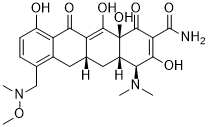This product is for research use only, not for human use. We do not sell to patients.

| Size | Price | Stock |
|---|---|---|
| 10mg | $200 | To Be Confirmed |
| 25mg | $340 | To Be Confirmed |
| 50mg | $510 | To Be Confirmed |
| 100mg | $769 | To Be Confirmed |
| 250mg | $1340 | To Be Confirmed |
| 500mg | $1950 | To Be Confirmed |
Cat #: V3871 CAS #: 1035654-66-0 Purity ≥ 98%
Description: Sarecycline (formerly known as WC-3035 and P005672; trade name: Seysara) is the first narrow spectrum tetracycline-class antibiotic being developed for acne treatment. In Oct 2018, FDA approved Sarecycline for the treatment of inflammatory lesions of non-nodular moderate to severe acne vulgaris in patients 9 years of age and older. In addition to exhibiting activity against important skin/soft tissue pathogens, sarecycline exhibits targeted antibacterial activity against clinical isolates of Cutibacterium acnes In the current study, sarecycline was 16 to 32-fold less active than broad spectrum tetracyclines-such as minocycline and doxycycline-against aerobic Gram-negative bacilli associated with normal human intestinal microbiome. Also, reduced activity against Escherichia coliwas observed in vivo in a murine septicemia model with PD50 values at >40 mg/kg and 5.72 mg/kg for sarecycline and doxycycline, respectively. Sarecycline was also 4 to 8-fold less active against representative anaerobic bacteria that also comprise normal human intestinal microbiome. Additionally, sarecycline displayed a low propensity for resistance development in C. acnes strains, with spontaneous mutation frequencies of 10-10 at 4 to 8-times the MIC, similar to minocycline and vancomycin. When tested against Gram-positive pathogens with defined tetracycline resistance mechanisms, sarecycline was more active than tetracycline against the tet(K) and tet(M) strains, with MIC ranging from 0.125 to 1.0 ug/mL and 8 ug/mL, respectively, compared with 16 to 64 ug/mL and 64 ug/mL for tetracycline, respectively. However, sarecycline activity in the tet(K) and tet(M) strains were decreased compared to wildtype, which demonstrated MIC ranging from 0.06 to 0.25 ug/mL, though not as pronounced as tetracycline.
Publications Citing InvivoChem Products
Product Promise

- Physicochemical and Storage Information
- Protocol
- Related Biological Data
- Stock Solution Preparation
- Quality Control Documentation
| Molecular Weight (MW) | 487.51 |
|---|---|
| Molecular Formula | C24H29N3O8 |
| CAS No. | 1035654-66-0 |
| Storage | -20℃ for 3 years in powder form |
| -80℃ for 2 years in solvent | |
| Solubility In Vitro | DMSO: 10 mM |
| Water: N/A | |
| Ethanol: N/A | |
| SMILES Code | O=C(C1=C(O)[C@@H](N(C)C)[C@@](C[C@@]2([H])C(C(C3=C(O)C=CC(CN(OC)C)=C3C2)=O)=C4O)([H])[C@@]4(O)C1=O)N |
| Synonyms | WC-3035; WC 3035; WC3035; P005672; P-005672; P 005672; P005672; trade name: Seysara |
| Solvent volume to be added | Mass (the weight of a compound) | |||
|---|---|---|---|---|
| Mother liquor concentration | 1mg | 5mg | 10mg | 20mg |
| 1mM | 2.0512 mL | 10.2562 mL | 20.5124 mL | 41.0248 mL |
| 5mM | 0.4102 mL | 2.0512 mL | 4.1025 mL | 8.2050 mL |
| 10mM | 0.2051 mL | 1.0256 mL | 2.0512 mL | 4.1025 mL |
| 20mM | 0.1026 mL | 0.5128 mL | 1.0256 mL | 2.0512 mL |
This equation is commonly abbreviated as: C1 V1 = C2 V2
- (1) Please be sure that the solution is clear before the addition of next solvent. Dissolution methods like vortex, ultrasound or warming and heat may be used to aid dissolving.
- (2) Be sure to add the solvent(s) in order.




































